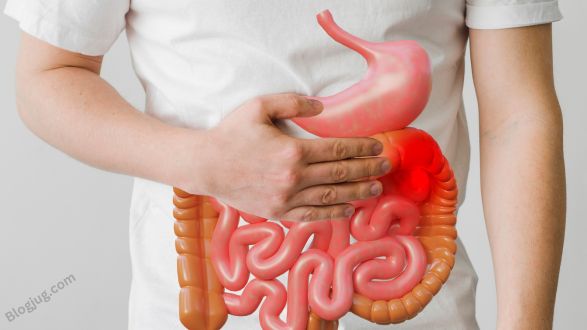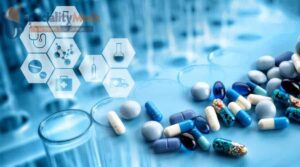From the top of your body, which is your mouth, to the bottom, which is your anus, food travels through your body in an amazing way. As the good components of your diet are absorbed, you get nutrition and energy. This is a detailed explanation of how the digestive system functions.

Overview
What is the digestive system?
The network of organs that makes up your digestive system aids in the breakdown and absorption of nutrients from food. It consists of your biliary system and gastrointestinal tract (GI tract). The hollow organs that make up your GI tract are related to one another and extend from your mouth to your anus. The three organs that make up your biliary system work together to transport bile and digestive enzymes to your GI tract via your bile ducts.
Gastrointestinal (GI) tract
Your mouth, esophagus, stomach, small intestine, large intestine, and anus are the organs that comprise your GI tract, in the order that they are joined.
Biliary system
Your pancreas, liver, gallbladder, and bile ducts are all part of your biliary system.
What does the digestive system do?
Because of the way it is designed, your digestive system can convert food into the nutrients and energy your body needs to survive. When it’s finished, it neatly compresses your stool, or solid waste, for disposal the next time you have a bowel movement.
Why is digestion important?
Because your body needs nutrients from the food you consume and the liquids you drink to keep healthy and function correctly, digestion is crucial. Nutrients include things like water, lipids, proteins, vitamins, and minerals. Nutrients from meals and liquids are broken down and absorbed by your digestive system for use in vital processes including cell growth, repair, and energy production.
Anatomy
What organs make up the digestive system?
The organs together referred to as your gastrointestinal tract comprise the major components of your digestive system. The anus, small, large, and esophageal sphincters, stomach, and mouth are among them. Your gastrointestinal system is supported during this process by your liver, gallbladder, and pancreas.
This is the way the organs work together in your digestive system.
Mouth
The digestive system starts in the mouth. In actuality, digestion starts as soon as you bite into something. As soon as you see and smell the warm bread or spaghetti dish, your salivary glands start to work. You chew your meal into smaller, easier-to-digest pieces after you start eating. When saliva and food combine, the food starts to break down into a form that your body can absorb and utilize. Your tongue moves the food down your throat and into your esophagus as you swallow.
Esophagus
When you swallow, food travels from your mouth to the esophagus, which is situated in your throat close to your trachea (windpipe). The epiglottis is a little flap that covers your windpipe to prevent choking if food lodges in it while swallowing. Food travels to your stomach by a series of contractions made by the muscles in your esophagus, known as peristalsis.
However, for food to pass through, the lower esophageal sphincter, a ring-shaped muscle at the base of the esophagus, must first relax. The sphincter then tightens, stopping the stomach’s contents from returning to the esophagus. (You can have acid reflux or heartburn if it doesn’t and these contents flow back into the esophagus.)
Stomach
The stomach is a “container,” or hollow organ, that stores food while it is combined with digestive enzymes. These enzymes carry on the process of transforming food into a state that can be consumed. The breakdown process is carried out by strong acids and potent enzymes secreted by stomach lining cells. The stomach’s contents are discharged into the small intestine when they have been sufficiently digested.
Small intestine
The small intestine is a muscular tube that is 22 feet long and is made up of three segments: the duodenum, jejunum, and ileum. It breaks down food utilizing bile from the liver and pancreatic enzymes. This organ also functions through peristalsis, which transports food through and combines it with the liver’s and pancreatic’s digesting secretions.
The first segment of the small intestine is called the duodenum. It’s mostly to blame for the ongoing breakdown process. The lower intestine’s jejunum and ileum are primarily in charge of absorbing nutrients into the bloodstream.
The semi-solid contents of the small intestine eventually turn liquid as they move through the organ. Mucus, water, bile, and enzymes all contribute to the consistency shift. After the nutrients are absorbed, the liquid remaining from the meal moves from the small intestine to the large intestine (colon).
Pancreas
Protein, lipids, and carbs are broken down in the duodenum by digestive enzymes secreted by the pancreas. Additionally, insulin is produced by the pancreas and enters the bloodstream directly. Your body uses insulin as its main hormone to metabolize sugar.
Liver
Although the liver performs a variety of tasks in the digestive system, processing the nutrients taken up from the small intestine is its primary duty. The liver secretes bile into the small intestine, which is essential for breaking down fat and several vitamins.
Your body uses the liver as a chemical “factory.” It creates all the different chemicals your body requires to function from the raw materials your intestine absorbs.
Additionally, the liver detoxifies potentially dangerous substances. It degrades and secretes a variety of medications that may be harmful to your health.
Gallbladder
Bile from the liver is concentrated and stored in the gallbladder, which then releases it into the duodenum in the small intestine to aid with fat absorption and digestion.
Colon
Waste is processed by the colon to make it simple and straightforward to empty your bowels. The muscular tube that joins the small intestine to the rectum is 6 feet long.
The parts of the colon are the cecum, ascending (right), descending (left), transverse (across), and sigmoid (connected to the rectum) colons.
Through the process of peristalsis, waste from the digestive process—known as stool—is moved through the colon. It is liquid at first, but it solidifies with time. Water is expelled from the stool as it moves through the colon. Once or twice a day, a “mass movement” forces the sigmoid (S-shaped) colon to empty its contents into the rectum.
Stool typically passes through the colon in around 36 hours. Most of the material in the feces is bacteria and food scraps. These “good” bacteria process food particles and waste items, synthesize different vitamins, and guard against harmful bacteria, among other beneficial tasks. A bowel movement occurs when the descending colon releases its contents into the rectum after filling up with stool, or feces.
Rectum
The 8-inch-long, straight chamber that connects the anus and colon is called the rectum. The stool is collected from the colon by the rectum, which also serves to alert you when it needs to be evacuated (pooped out) and holds onto it until it does. When anything, like gas or feces, enters the rectum, sensors notify the brain. The brain then decides whether to empty the contents of the rectal cavity.
The contents of the rectum are ejected when the sphincters relax and the rectum contracts. The sphincter contracts and the rectum accommodates if the contents cannot be rid of, temporarily relieving the sensation.
Anus
The anus is the final portion of the digestive system. The pelvic floor muscles and the two anal sphincters—internal and external—compose this 2-inch-long canal. The rectal contents can be sensed by the lining of the upper anus. It indicates to you if the contents are solid, gas, or liquid.
Sphincter muscles, which are crucial for controlling stool, encircle the anus. The stool cannot come out when it shouldn’t because of the angle that the pelvic floor muscle forms between the rectum and the anus. Except in cases where feces enters the rectum, the internal sphincter is always tight. This keeps us continent, meaning it stops us from passing gas when we’re sleeping or otherwise unconscious of the presence of feces.
Our external sphincter helps us control our urge to use the restroom by holding the stool in place until we go to the toilet, at which point it relaxes and releases its contents.
Conditions and Disorders
What ailments frequently impact the digestive system?
The digestive system can be impacted by both short-term and long-term, or chronic, illnesses and disorders. It’s normal to occasionally have ailments like heartburn, diarrhea, or constipation. Make sure to get in touch with your healthcare provider if you are frequently having digestive problems such as these. It can indicate a more serious illness that requires medical diagnosis and treatment.
The following are some short-term or transient disorders that impact the digestive system:
1. Constipation: Constipation is typically experienced when bowel movements are less frequent than usual. Constipation causes your stool to become stiff and dry and makes passing it uncomfortable and difficult.
2. Diarrhea: A poop that is runny or loose is called diarrhea. Many factors, including bacteria, can cause diarrhea, but occasionally the reason is not recognized.
3. Heartburn: Heartburn, despite its name containing the word “heart,” is a digestive problem. A burning sensation that is uncomfortable and can travel up your neck and throat is called heartburn. It occurs when stomach acid travels back up your esophagus during digestion.
4. Hemorrhoids: Veins that swell and expand inside and outside the anus and rectum are known as hemorrhoids. They may result in rectal bleeding and be uncomfortable and painful.
5. Stomach flu (gastroenteritis): The stomach flu is a viral infection that often affects the upper portion of the small intestine and the stomach. Usually, it doesn’t last more than a week. Each year, millions of people contract the stomach flu.
6. Ulcers: An ulcer is a lesion that appears on the lining of the stomach, small intestine, or esophagus. The most frequent causes of ulcers are prolonged use of anti-inflammatory medications like ibuprofen and Helicobacter pylori (H. pylori) infection.
7. GERD (chronic acid reflux): The illness known as gastroesophageal reflux disease, or chronic acid reflux, is characterized by recurrent reflux of stomach acid into the esophagus.
8. Irritable bowel syndrome (IBS): Your gut muscle contracts more or less frequently than usual if you have IBS. Abdominal pain, cramping, and excessive gas are all symptoms of IBS.
9. Lactose intolerance: Lactose is a sugar that is mostly present in milk and dairy products, and those who are lactose intolerant cannot digest it.
10. Cancer: Gastrointestinal (GI) cancers are those that impact digestive system tissues and organs. GI malignancies come in a variety of forms. Esophageal cancer, stomach cancer, colon and rectal cancer, pancreatic cancer, and liver cancer are the most frequent cancers of the digestive system.
11. Crohn’s disease: An inflammatory bowel disease that lasts a lifetime is Crohn’s disease (IBD). The digestive tract is irritated by the illness.
12. Celiac disease: Your small intestine may sustain damage if you have celiac disease, an autoimmune condition. Gluten, a protein included in wheat, barley, and rye, causes harm to a person who has celiac disease.
Care
How can I keep my digestive system healthy?
Always consult your healthcare practitioner about what to eat and do to maintain your health and manage any medical conditions you may have. You can generally maintain the health of your digestive system by doing the following:
1. Drink water often: Drinking water facilitates the easier passage of food via your digestive tract. Constipation is frequently brought on by low water content in the body, or dehydration.
2. Include fiber in your diet: Fiber improves digestion and promotes regular bowel motions in your body. Make sure your diet contains both soluble and insoluble fiber.
3. Eat a balanced diet: Make sure you consume multiple portions of fruits and veggies each day. Avoid processed foods altogether and go for whole grains instead of processed ones. Limit your intake of any deli (processed) meats and opt for fish and poultry more often than red meat. Cut back on the amount of sugar you consume.
4. Eat foods with probiotics or take probiotic supplements: Good bacteria in probiotics aid in the defense against harmful bacteria in your digestive system. They also produce beneficial compounds that support digestive health. After taking an antibiotic, it can be especially beneficial to take probiotics because drugs frequently destroy both healthy and bad bacteria in the gut.
5. Eat mindfully and chew your food: Eating gradually allows your body to process food effectively. It also enables your body to communicate with you when it is full. Chewing food completely is essential because it ensures your body produces adequate saliva, or spit, for digestion. It also facilitates the absorption of nutrients by your digestive system when you chew your food thoroughly.
6. Exercise: Food passes through your digestive system more easily when you move and experience gravity. For example, walking after a meal can facilitate easier food digestion in your body.
7. Avoid alcohol and smoking: Alcohol can make your stomach produce more acid, which can lead to acid reflux, heartburn, and stomach ulcers. You practically quadruple your risk of acid reflux if you smoke. Studies reveal that quitting smoking improves symptoms in those with digestive problems.
8. Manage your stress: Digestive problems like diarrhea, IBS, and constipation are linked to stress.
When should I discuss digestive system problems with my healthcare provider?
If you frequently have symptoms like constipation, diarrhea, vomiting, cramping in your stomach, excessive gas (farting), or heartburn, make an appointment with your doctor. While most people occasionally experience these ailments, if you do so frequently, it may indicate a more significant problem with your digestive system.









2 thoughts on “Digestive System: Organs & Anatomy, Function”